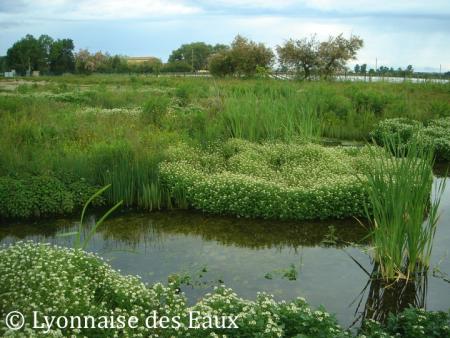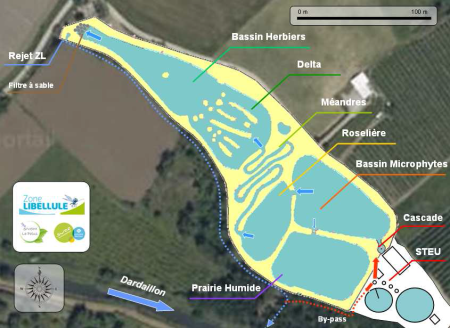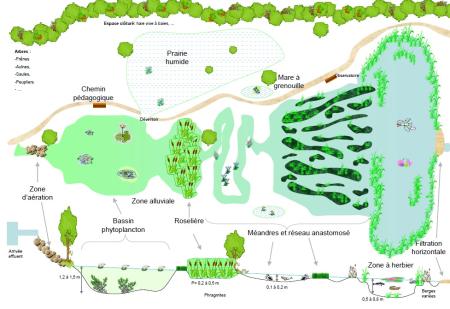
Area characterisation:
Implementation scale: Neighborhood, park, object
Impact scale: Neigborhood, City, National (Duplication of Libellule zona trhoughout the country)
Urban density: Low (suburb at the limit with rural areas, etc.)
Objective:
The goal of the project is to develop and industrialise planted discharge areas at the
exit of treatment plants to convert them into a genuine artificial wetland guaranteeing the treatment of micropollutants and ecological diversity.
Other environmetal friendly solutions: Phytoremediation
Images
Financing:
Global (estimated) cost of the project: 1M€- 5M€
Financing mechanism: cluster4 public private
There are 2 projects in series, for the first to 300 k€, 50% AERMC, 20% county council of Herault, France (34), 30% Lyonnaise.
Potential impacts/benefits:
An effective solution: 317 molecules sought, 81% of the quantified molecules were
eliminated at → 30% of which more than half → 70%.
Transferability of result:
Process enablers:
Knowledge drivers → Information accessibility → knowledge platforms
Knowledge of the NbS in the city within the stakeholders were available. We had a facility to acquire the missing knowledge through various partnerships.
Process inhibitors:
... → ... → ...
...
Expected life time of the intervention: ...
Feedback: ...
Expected time for the NbS to become fully effective after its implementation: ...
Dates (for project delivered): 2015
BUSINESS MODEL:
Business cluster: ...
Business model: ...
An effective solution. 317 molecules sought, 81% of the quantified molecules were
eliminated at> 30% of which more than half> 70%
Client:
Suez Environnement (Contracting authority)
Design team:
- Suez Environnement (Project manager)
Main partners:
- Lyonnaise des Eaux and Eurofins Scienti fic Groups
- SME Rive and Nymphea
- Many others: SIVU, Agence de l'eau RMC, CD 34, Biotope, CNRS, IRSTEA and other research structures and companies...
- Biodiagnostics Unit of LERES CITERES (Interdisciplinary Academic Centre: Cities, Territories, Environment and Societies) laboratory at the University of Tours.
GOVERNANCE MODEL:
Governance cluster: ...
Governance model: ...
Contacts:
Olivier , DAMAS (olivier.damas@plante-et-cite.fr)
Plante & Cité (Non-profit organization - https://www.plante-et-cite.fr/)
Maison du Végétal, 26 Rue Jean Dixmeras, 49000 Angers
NBS goals:
- Restoring ecosystems and their functions
- Developing climate change mitigation
- Improving risk management and resilience
- Multi-functional nature-based watershed management and ecosystem restoration
- Nature-based solutions and the insurance value of ecosystems
NBS benefits:
- Developing climate change adaptation; improving risk management and resilience
- Increase infiltration / Water storage
- Reducing temperature at meso or micro scale
- Restoring ecosystems and their functions
- Improve connectivity and functionality of green and blue infrastructures
- Increase achievements of biodiversity targets
- Increase Biodiversity
- Increase quality and quantity of green and blue infrastructures
- Creation of green jobs relating to construction & maintenance of NBS
- Improve water quality
- Increase population & infrastructures protected by NBS
- Increase willingness to invest in NBS
- Reduce costs for water treatments
Further information:
Nature4Cities (https://www.nature4cities.eu/) aims to develop a knowledge diffusion around Nature-Based Solution (NbS) and a decision support platform through new collaborative models.
This project is part of the Nature4Cities's pioneer case studies database, it will feed the observatory, NbS pre-selection and replication tools, gathered into the Geocluster4NBS.
This project was chosen as a pioneer case study for the following reasons: the project is a complementary treatment of micro
pollutants and by creating biodiversity linked to the influx of water.
Nature4Cities project has received funding from the European Union’s Horizon 2020 research and innovation program under grant agreement No 730468.


